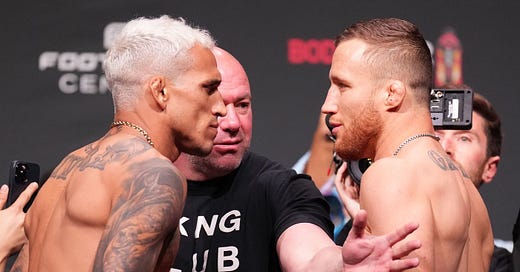Equilibrium Pricing in the UFC: Finding the Sweet Spot
Balancing Supply, Demand, and Profitability for Fight Night Success
The equilibrium price is the point at which the quantity of a product supplied matches the quantity demanded, creating balance in the market. In UFC terms, this applies to pay-per-view (PPV) pricing for fights. If the price is too high, fewer fans buy the PPV, resulting in unsold streams (a surplus). If the PPV price is too low, the event sells out but may not generate enough revenue to cover production costs or maximize profit (a shortage). Finding the right price ensures the UFC meets fan demand while achieving its financial goals.
Justin “The Highlight” Gaethje is a fan favorite known for his explosive striking and relentless pace. He’s a former interim lightweight champion who has headlined multiple PPVs. On the other hand, Charles Oliveira, the record-holder for the most finishes in UFC history, is a submission specialist. As a former lightweight champion, he’s also proven his ability to sell fights. For Instance, UFC 280 Oliveira vs Makhachev had 650,000 PPV buys. However, the UFC 280 card also had big draws like Petr Yan, Sean O’Malley, T.J Dillashaw, and Aljamain Sterling that contributed to PPV buys.
If the UFC initially sets the PPV price at $99.99 for Gaethje vs. Oliveira, hardcore fans may be willing to pay. However, casual viewers might think the price is too steep for a fight without a massive superstar like Conor McGregor. This could result in fewer purchases and a supply surplus, with streams left unsold. If the UFC lowers the price to $49.99, demand increases significantly, especially among casual fans. However, this creates a demand surplus, where the event sells well but generates less revenue than it could at a higher price. After testing the market, the UFC finds an equilibrium price of $74.99. At this level, hardcore fans feel the price reflects the quality of the fighters, while casual fans find it affordable enough to buy. This price point helps the UFC balance fan satisfaction with profitability. This equilibrium ensures the event’s financial success while honoring the fighters’ efforts and appeal.




